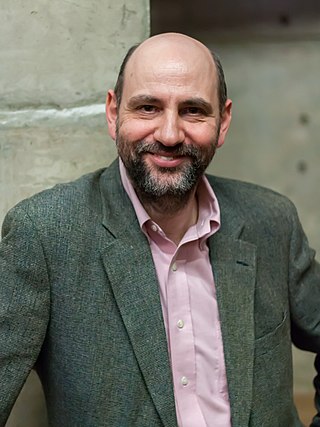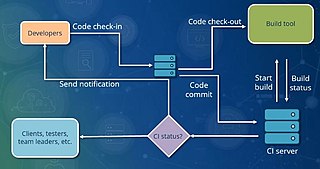Related Research Articles

Kent Beck is an American software engineer and the creator of extreme programming, a software development methodology that eschews rigid formal specification for a collaborative and iterative design process. Beck was one of the 17 original signatories of the Agile Manifesto, the founding document for agile software development. Extreme and Agile methods are closely associated with Test-Driven Development (TDD), of which Beck is perhaps the leading proponent.

Martin Fowler is a British software developer, author and international public speaker on software development, specialising in object-oriented analysis and design, UML, patterns, and agile software development methodologies, including extreme programming.

Howard G. Cunningham is an American computer programmer who developed the first wiki and was a co-author of the Manifesto for Agile Software Development. A pioneer in both design patterns and extreme programming, he started coding the WikiWikiWeb in 1994, and installed it on c2.com on March 25, 1995, as an add-on to the Portland Pattern Repository. He co-authored a book about wikis, entitled The Wiki Way, and invented the Framework for Integrated Test.
The following outline is provided as an overview of and topical guide to software engineering:
In software development, agile practices include requirements discovery and solutions improvement through the collaborative effort of self-organizing and cross-functional teams with their customer(s)/end user(s), adaptive planning, evolutionary development, early delivery, continual improvement, and flexible responses to changes in requirements, capacity, and understanding of the problems to be solved. Popularized in the 2001 Manifesto for Agile Software Development, these values and principles were derived from and underpin a broad range of software development frameworks, including Scrum and Kanban.
James O. Coplien, also known as Cope, is a writer, lecturer, and researcher in the field of computer science. He held the 2003–4 Vloeberghs Leerstoel at Vrije Universiteit Brussel and has been a visiting professor at University of Manchester.
"You aren't gonna need it" (YAGNI) is a principle which arose from extreme programming (XP) that states a programmer should not add functionality until deemed necessary. Other forms of the phrase include "You aren't going to need it" (YAGTNI) and "You ain't gonna need it" (YAGNI).

In software engineering, continuous integration (CI) is the practice of merging all developers' working copies to a shared mainline several times a day. Nowadays it is typically implemented in such a way that it triggers an automated build with testing. Grady Booch first proposed the term CI in his 1991 method, although he did not advocate integrating several times a day. Extreme programming (XP) adopted the concept of CI and did advocate integrating more than once per day – perhaps as many as tens of times per day.
In software development and product management, a user story is an informal, natural language description of features of a software system. They are written from the perspective of an end user or user of a system, and may be recorded on index cards, Post-it notes, or digitally in project management software. Depending on the project, user stories may be written by different stakeholders like client, user, manager, or development team.
Agile modeling (AM) is a methodology for modeling and documenting software systems based on best practices. It is a collection of values and principles, that can be applied on an (agile) software development project. This methodology is more flexible than traditional modeling methods, making it a better fit in a fast changing environment. It is part of the agile software development tool kit.
Big Design Up Front (BDUF) is a software development approach in which the program's design is to be completed and perfected before that program's implementation is started. It is often associated with the waterfall model of software development.
Extreme programming (XP) is an agile software development methodology used to implement software projects. This article details the practices used in this methodology. Extreme programming has 12 practices, grouped into four areas, derived from the best practices of software engineering.
A lightweight methodology is a software development method that has only a few rules and practices, or only ones that are easy to follow. In contrast, a complex method with many rules is considered a "heavyweight methodology".

Ron Jeffries is one of the three founders of the Extreme Programming (XP) software development methodology circa 1996, along with Kent Beck and Ward Cunningham. He was from 1996, an XP coach on the Chrysler Comprehensive Compensation System project, which was where XP was invented. He is an author of Extreme Programming Installed, the second book published about XP. He has also written Extreme Programming Adventures in C#. He is one of the 17 original signatories of the Agile Manifesto.
Matt Stephens is an author and software process expert based in London, UK. In January 2010 he founded independent book publisher Fingerpress UK Ltd, and in November 2014 he founded the Virtual Reality book discovery site Inkflash.
In software engineering, a software development process is a process of dividing software development work into smaller, parallel, or sequential steps or sub-processes to improve design and/or product management. It is also known as a software development life cycle (SDLC). The methodology may include the pre-definition of specific deliverables and artifacts that are created and completed by a project team to develop or maintain an application.

Extreme programming (XP) is a software development methodology intended to improve software quality and responsiveness to changing customer requirements. As a type of agile software development, it advocates frequent releases in short development cycles, intended to improve productivity and introduce checkpoints at which new customer requirements can be adopted.
eXtreme Manufacturing (XM) is an iterative and incremental framework for manufacturing improvement and new product development that was inspired by the software development methodology Scrum and the systematic waste-elimination (lean) production scheduling system Kanban(かんばん ).
Agile usability engineering is a method created from a combination of agile software development and usability engineering practices. Agile usability engineering attempts to apply the principles of rapid and iterative development to the field of user interface design.
Communication in Distributed Software Development is an area of study that considers communication processes and their effects when applied to software development in a globally distributed development process. The importance of communication and coordination in software development is widely studied and organizational communication studies these implications at an organizational level. This also applies to a setting where teams and team members work in separate physical locations. The imposed distance introduces new challenges in communication, which is no longer a face to face process, and may also be subjected to other constraints such as teams in opposing time zones with a small overlap in working hours.
References
- Jim Highsmith (editor) Agile Software Development Ecosystems ISBN 0-201-76043-6
- Martin Fowler, Refactoring, Addison-Wesley Professional, ISBN 0-201-48567-2
- Kevin J. Aguanno, Managing Agile Projects, Multi-Media Publications Inc, 2005. ISBN 1-895186-11-0, page 33